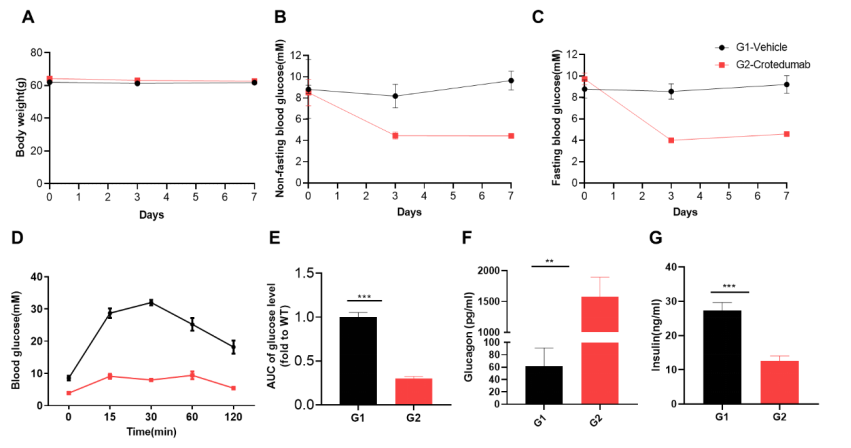Spontaneous Diabetes Mouse Model
Leptin is a peptide hormone secreted by adipocytes and is mainly expressed by white adipose tissue. Additionally, leptin is also found to be expressed in the myocardium, skeletal muscle, placenta, lung, breast epithelium, and gastric mucosa. Functionally, leptin can inhibit appetite, increase energy expenditure, and inhibit fat synthesis to promote its decomposition. Insulin can promote the secretion of leptin, which in turn plays a negative feedback regulatory role in the synthesis and secretion of insulin.
B-ob/ob mice (Product number 110172) were generated by knocking out exons 2 and 3 of the leptin gene using EGE technology. B-ob/ob mice are a powerful model for studying modulators of obesity and hyperglycemia.
-
Efficacy Evaluation of Crotedumab in B-ob/ob Mice
-
Experimental animals: B-ob/ob mice, male, 8-10 weeks old

Efficacy of the anti-human GCGR antibody drug Crotedumab (synthesized in-house) in B-ob/ob mice. 8-10-week old male B-ob/ob mice were randomly assigned to 2 groups of 6-7 animals each, Crotedumab dosing occurred on Day 0. Non-fasting blood glucose was measured on days 0, 3, and 7, and fasting blood glucose was measured after 6 hours of fasting. (A) Body weight changes in B-ob/ob mice, (B-C) non-fasting blood glucose and fasting blood glucose measurements, (D) Crotedumab effect on glucose tolerance, (E) area under the curve of blood glucose content were measured in vehicle and Crotedumab-treated B-ob/ob mice. Mice were fasted for 6 h with unlimited access to water, after which fasting blood glucose was measured at the tail tip (0 min). Subsequently, glucose was injected intraperitoneally at 2 g/kg, and blood glucose was measured at the indicated times. (F-G) Glucagon and insulin measurements were also recorded. Results indicate that Crotedumab had hypoglycemic effects in both fasting and non-fasting conditions, and improved glucose tolerance in B-ob/ob mice. (Data is represented as mean ± SEM; P ≤ 0.05, P ≤ 0.01, P ≤ 0.001)
-
Efficacy Evaluation of Dulaglutide in B-ob/ob Mice
-

Anti-obesity and hypoglycemic effect of Dulaglutide in B-ob/ob mice. (A-B) Body weight and change in blood glucose levels in B-ob/ob mice were recorded from 4-21 weeks old. (C-F) B-ob/ob mice (9-weeks-old) were administrated 1 mg/kg Dulaglutide (in house) twice per week for 4 weeks after grouping. Body weight and blood glucose levels were recorded at the indicated time. Glucose tolerance tests were performed the day after the last dose (n=8 mice per group. (G-J) Biochemical blood tests showed the therapeutic effect of Dulaglutide on B-ob/ob mice. Values are expressed as mean ± SEM. **p<0.01, ***p<0.001. (n=8 mice per group).
-
Product List
-
Product Name Catalog Number B-ob/ob mice 110172 B-hGCGR mice 110105 B-hGLP1R mice 170164



